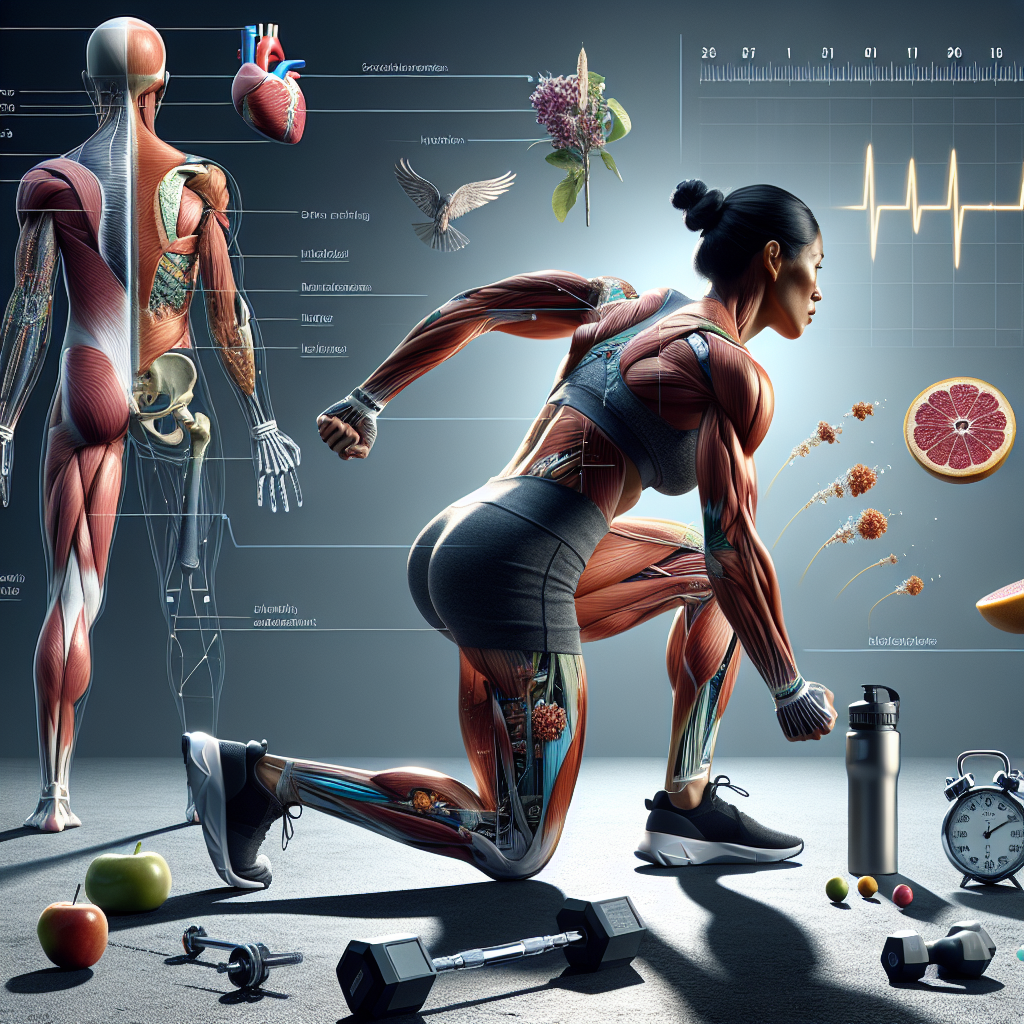Basic Exercise Science RP: A Beginner’s Blueprint

The journey into fitness is a voyage of understanding how the body responds, adapts, and thrives under the stress of physical exercise. Grasping the basic exercise science rp is crucial for anyone looking to establish a solid foundation in their workout routine. Exercise science encompasses a broad scope of disciplines including biology, physiology, kinesiology, and nutrition, each contributing valuable insights into the most effective ways to improve health and performance.
An integral component of exercise science is understanding how different types of exercise—cardiovascular, strength training, flexibility, and balance—affect the body. This knowledge is pivotal for crafting workouts that meet personal goals, whether they are focused on weight loss, muscle gain, improved athletic performance, or general health maintenance.
Another key element is the role of progressive overload, which is the gradual increase of stress placed upon the body during exercise training. This principle is the cornerstone of strength and endurance building, ensuring continuous improvement without plateauing. Additionally, recognizing the importance of proper nutrition and recovery strategies cannot be overstressed, as they are essential to fuel workouts and facilitate muscle repair, respectively.
For those eager to delve deeper into the world of fitness and optimize their workout regimen, Explore More at Muscle Theory, where a treasure trove of information awaits to guide you through the complexities of basic exercise science rp.
Exploring the Components of a Balanced Workout

A balanced workout is akin to a symphony, where every element works in harmony to create a holistic fitness experience. There are four primary components that should be included in a well-rounded exercise routine: strength training, cardiovascular exercises, flexibility workouts, and balance training. Each plays a vital role in ensuring comprehensive physical fitness.
Strength training is essential for building and maintaining muscle mass, which in turn helps to boost metabolic rate and increase overall strength. Exercises such as lifting weights, using resistance bands, or performing bodyweight exercises like push-ups and squats are excellent for this purpose.
Cardiovascular exercises, often referred to as cardio, are designed to improve the efficiency of the cardiovascular system. Activities like running, swimming, or cycling are effective in enhancing heart health, increasing lung capacity, and burning calories.
Flexibility workouts, which include stretching and yoga, are important for maintaining a full range of motion in the joints, reducing the risk of injuries, and improving posture. Lastly, balance training helps to improve body awareness and can prevent falls, especially as we age. Balance exercises can be as simple as standing on one foot or as complex as practicing tai chi.
Integrating these components into your exercise routine not only ensures a comprehensive approach to fitness but also keeps workouts diverse and engaging, helping to maintain motivation over the long term.
Decoding the Science Behind Muscle Growth and Recovery

Understanding the mechanisms of muscle growth and recovery is crucial for anyone looking to improve their physical fitness. Muscle growth, or hypertrophy, occurs as a result of consistent and progressive resistance training that challenges the muscle fibers. When muscles are subjected to stress beyond what they are accustomed to, it causes microscopic damage to the fibers, a process known as muscle protein breakdown.
Following this breakdown, the body initiates a repair process where cells called satellite cells fuse to the damaged fibers, facilitating their repair and growth. This is where muscle protein synthesis occurs, where new muscle proteins are formed to strengthen and enlarge the muscle. Adequate nutrition, particularly with sufficient protein intake, is essential for this synthesis process.
Recovery, on the other hand, is the phase where the body heals and replenishes itself after exercise. During this time, it’s not just about muscle repair but also about restoring glycogen stores, reducing inflammation, and managing hormonal balance. Adequate sleep and rest, proper hydration, and nutrition rich in antioxidants and anti-inflammatory components are vital for effective recovery.
It’s important to note that overtraining without sufficient recovery can lead to muscle fatigue and injury, which can set back fitness progress. Striking the right balance between workout intensity, duration, and recovery time is key to promoting muscle growth without overtaxing the body.
Nutrition Essentials for Fitness Beginners

Embarking on a fitness journey requires more than just dedication to a workout routine; it also demands attention to nutrition. For fitness beginners, understanding nutrition essentials is a foundational component of basic exercise science rp. It’s critical to fuel the body with the right balance of macronutrients: carbohydrates, proteins, and fats.
Carbohydrates are the body’s primary energy source, especially during high-intensity workouts. They should come from complex sources like whole grains, fruits, and vegetables, providing a steady release of energy. Proteins are the building blocks of muscle and are vital for recovery and growth. Lean meats, dairy, legumes, and plant-based alternatives are excellent protein sources.
Fats should not be overlooked as they play a pivotal role in hormone production and cellular health. Sources of healthy fats include avocados, nuts, seeds, and olive oil. Hydration is another critical aspect of nutrition; beginners should aim to drink plenty of water throughout the day, especially before, during, and after workouts to maintain optimal performance levels.
Lastly, micronutrients – vitamins and minerals – support overall health and are necessary for numerous bodily functions, including metabolic processes relevant to exercise. A diverse diet rich in colorful fruits and vegetables can help ensure adequate micronutrient intake.
While individual nutritional needs can vary, these basics provide a starting point for beginners to understand and implement a diet that supports their fitness goals.
Incorporating Exercise Science into Your Routine
Incorporating the principles of basic exercise science rp into your fitness routine can significantly enhance the effectiveness of your workouts and accelerate progress towards your goals. To begin with, understanding the importance of a well-structured workout plan is crucial. This plan should be based on your individual fitness level, goals, and the scientific concepts of periodization and progressive overload.
Periodization involves dividing your training schedule into specific cycles with targeted outcomes, such as building strength or endurance. Within each cycle, exercises, sets, reps, and rest periods are carefully calibrated to challenge the body and stimulate adaptation. Progressive overload, on the other hand, is the gradual increase of stress placed upon the body during exercise training. This can be achieved by increasing the weight lifted, altering the number of repetitions, or changing the length of rest periods between sets.
Another key element of exercise science is understanding the types of exercise: aerobic and anaerobic. Aerobic exercises, like running or cycling, improve cardiovascular health and endurance, while anaerobic exercises, such as weightlifting or sprinting, increase muscle strength and power. A balanced routine includes elements of both, catering to the body’s need for varied stimuli.
Lastly, proper form and technique are paramount for preventing injuries and ensuring that the correct muscle groups are being targeted. Beginners should seek guidance from certified fitness professionals to learn the correct execution of exercises. Regularly incorporating these scientific principles into your workout regimen will not only help optimize your physical development but also keep you engaged and motivated on your path to peak fitness.
Evaluating Progress and Adjusting Your Fitness Plan

Regular evaluation of your progress is an essential component of a successful fitness journey. Tracking changes in strength, endurance, body composition, and overall performance helps determine if your fitness plan aligns with the principles of basic exercise science rp. To assess your progress effectively, consider using a variety of methods including performance tests, body measurements, and reflective fitness journals.
Performance tests can be specific to your goals; for instance, if you aim to improve strength, regular one-rep max tests on major lifts can be indicative of progress. For endurance, timed runs or cycle tests can provide valuable data. Tracking body measurements, such as body fat percentage and muscle circumference, can offer insights into the physical changes resulting from your workout routine.
A fitness journal is an excellent way to reflect on your workouts, noting improvements in exercise execution, increases in weights lifted, or even how you felt during and after each session. This subjective data, combined with objective measurements, provides a holistic view of your fitness evolution.
When your evaluations indicate a plateau or a decline in progress, it’s time to adjust your plan. This might mean increasing the intensity of your workouts, altering your rest periods, or modifying your nutrition. Remember, the body adapulates to stress, so introducing new exercises or training methods can reignite progress.
Stay informed and continually optimize your workout regimen by exploring the latest in exercise science. Explore More at Muscle Theory to ensure your fitness plan is as effective and efficient as possible.



